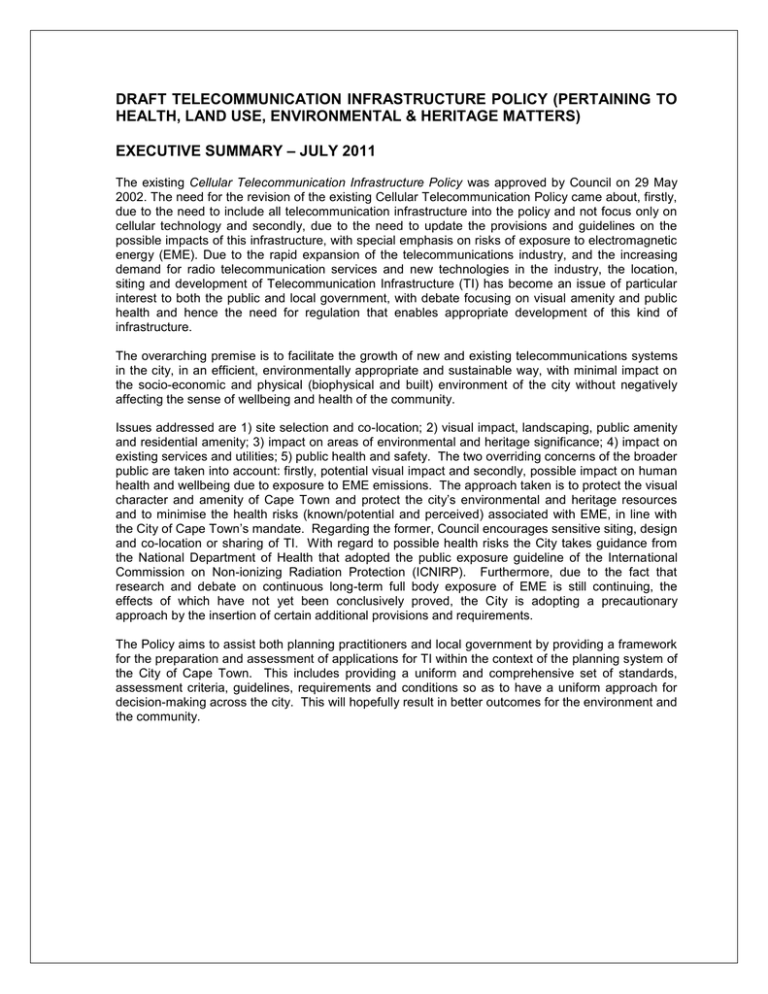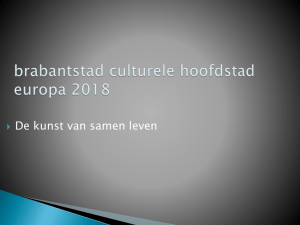DRAFT TELECOMMUNICATION INFRASTRUCTURE POLICY (PERTAINING TO
advertisement

DRAFT TELECOMMUNICATION INFRASTRUCTURE POLICY (PERTAINING TO HEALTH, LAND USE, ENVIRONMENTAL & HERITAGE MATTERS) EXECUTIVE SUMMARY – JULY 2011 The existing Cellular Telecommunication Infrastructure Policy was approved by Council on 29 May 2002. The need for the revision of the existing Cellular Telecommunication Policy came about, firstly, due to the need to include all telecommunication infrastructure into the policy and not focus only on cellular technology and secondly, due to the need to update the provisions and guidelines on the possible impacts of this infrastructure, with special emphasis on risks of exposure to electromagnetic energy (EME). Due to the rapid expansion of the telecommunications industry, and the increasing demand for radio telecommunication services and new technologies in the industry, the location, siting and development of Telecommunication Infrastructure (TI) has become an issue of particular interest to both the public and local government, with debate focusing on visual amenity and public health and hence the need for regulation that enables appropriate development of this kind of infrastructure. The overarching premise is to facilitate the growth of new and existing telecommunications systems in the city, in an efficient, environmentally appropriate and sustainable way, with minimal impact on the socio-economic and physical (biophysical and built) environment of the city without negatively affecting the sense of wellbeing and health of the community. Issues addressed are 1) site selection and co-location; 2) visual impact, landscaping, public amenity and residential amenity; 3) impact on areas of environmental and heritage significance; 4) impact on existing services and utilities; 5) public health and safety. The two overriding concerns of the broader public are taken into account: firstly, potential visual impact and secondly, possible impact on human health and wellbeing due to exposure to EME emissions. The approach taken is to protect the visual character and amenity of Cape Town and protect the city’s environmental and heritage resources and to minimise the health risks (known/potential and perceived) associated with EME, in line with the City of Cape Town’s mandate. Regarding the former, Council encourages sensitive siting, design and co-location or sharing of TI. With regard to possible health risks the City takes guidance from the National Department of Health that adopted the public exposure guideline of the International Commission on Non-ionizing Radiation Protection (ICNIRP). Furthermore, due to the fact that research and debate on continuous long-term full body exposure of EME is still continuing, the effects of which have not yet been conclusively proved, the City is adopting a precautionary approach by the insertion of certain additional provisions and requirements. The Policy aims to assist both planning practitioners and local government by providing a framework for the preparation and assessment of applications for TI within the context of the planning system of the City of Cape Town. This includes providing a uniform and comprehensive set of standards, assessment criteria, guidelines, requirements and conditions so as to have a uniform approach for decision-making across the city. This will hopefully result in better outcomes for the environment and the community. KONSEPBELEID OOR TELEKOMMUNIKASIE-INFRASTRUKTUUR (MET BETREKKING TOT GESONDHEIDS-, GRONDGEBRUIK-, OMGEWINGS- EN ERFENISAANGELEENTHEDE) BEKNOPTE OORSIG - JULIE 2011 Die Raad het die bestaande beleid oor sellulêre telekommunikasie-infrastruktuur op 29 Mei 2002 goedgekeur. ‘n Hersiening van die bestaande beleid oor sellulêretelekommunikasie-infrastruktuur was in die eerste plek nodig omdat daar ’n behoefte was om alle telekommunikasie-infrastruktuur by die beleid in te sluit en nie slegs op sellulêre tegnologie te fokus nie, en in die tweede plek weens die noodsaaklikheid om die bepalings en riglyne oor die moontlike impakte van hierdie infrastruktuur by te werk, met spesiale klem op die risiko’s verbonde aan blootstelling aan elektromagnetiese energie (EME). As gevolg van die vinnige uitbreiding van die telekommunikasie-industrie en die toenemende vraag na radiotelekommunikasiedienste en nuwe tegnologieë in die sellulêrefoon-industrie het die ligging, plasing en ontwikkeling van telekommunikasie-infrastruktuur (TI) vir beide plaaslike gemeenskap en plaaslike regering ‘n kwessie van besondere belang geword, met die debat wat op visuele aanneemlikheid en openbare gesondheid gerig is, en vandaar die noodsaaklikheid vir regulering wat die gepaste ontwikkeling van hierdie soort infrastruktuur moontlik maak. Die oorkoepelende uitgangspunt is die fasilitering van die groei van nuwe en bestaande telekommunikasiestelsels en die voorsiening van TI op ’n doeltreffende, omgewingsgepaste en volhoubare wyse, met die minimum impak op die stad se sosio-ekonomiese en fisiese (biofisiese en beboude) omgewing en sonder ’n negatiewe impak op die gemeenskap se gevoel van welstand en gesondheid. Kwessies wat aandag geniet, is 1) keuse en deel van perseel; 2) visuele impak, terreinverfraaiing, openbare aanneemlikheid en residensiële aannneemlikheid; 3) impak op gebiede van omgewingsen erfenisbelang; 4) impak op bestaande dienste en nutsdienste; en 5) openbare gesondheid en veiligheid. Die publiek se twee oorheersende bekommernisse word in ag geneem: eerstens, die potensiële visuele impak, en tweedens die moontlike impak van EME-vrystellings op die mens se gesondheid en welstand. Die benadering wat gevolg word, is om in pas met die Stad Kaapstad se mandaat Kaapstad se visuele karakter en aanneemlikheid en sy omgewing- en erfenishulpbronne te beskerm, met so min as moontlik gesondheidsrisiko’s (bekend/potensieel en waargeneem) as gevolg van EME. Wat eersgenoemde betref, moedig die Raad sensitiewe plasing, ontwerp en deel van TIpersele aan sodat omgewings- en erfenishulpbronne nie negatief geraak word nie. Met betrekking tot moontlike gesondheidsrisiko’s neem die Stad leiding van die nasionale departement van gesondheid wat die internasionale kommissie oor nie-ioniserende bestralingsbeskerming (ICNIRP) se standaard oor openbare blootstelling aanvaar het. Verder, weens die feit dat navorsing en debat oor voortgesette langtermyn-volleliggaamblootsteling aan EME steeds aan die gang is en die uitwerking daarvan nog nie onweerlegbaar bewys is nie, volg die Stad ’n benadering van voorsorg deur sekere bykomende bepalinge en vereistes in te voeg. Die hoofdoel van hierdie beleid is om plaaslike regering en beplanningspraktisyns te help om TI op ’n plaaslike vlak te reguleer deur ’n raamwerk vir die evaluering van TI-aansoeke binne die konteks van die Stad Kaapstad se beplanningstelsel te verskaf. Dit sluit in die verskaffing van ’n eenvormige en omvattende stel standaarde, evalueringskriteria, riglyne, vereistes en voorwaardes met die oog op so min as moontlik onsekerheid met besluitneming en beter uitkomste vir die gemeenskap. UYILO LOMGAQO-NKQUBO OLAWULO IZISEKO ZOPHUHLISO ZONXIBELELWANO NGEMINXEBA (OPHATHELENE NEMICIMBI YEZEMPILO, USETYENZISO-MHLABA, OKUSINGQONGILEYO NEYOKULILIFA) ISISHWANKATHELO SESIGQEBA – JULAYI 2011 UMgaqo-nkqubo okhoyo olawula iZiseko zoPhuhliso kuNxibelelwano ngonomyayi waphunyezwa liBhunga ngomhla wama-29 Meyi 2002. Kwabakho imfuneko yokuphengululwa koMgaqo-nkqubo okhoyo olawula uNxibelelwano ngooNomyayi, okokuqala, ngenxa yemfuneko yokubandakanya zonke izibonelelo zophuhliso kunxibelelwano ngeminxeba kumgaqo-nkqubo kungagxilwa nje kuphela kubuchwepheshe ngoonomyayi yaye okwesibini, ngenxa yemfuneko yokuhlaziya imiqathango nezikhokelo kwiimpembelelo ezinokubakho zezi ziseko zophuhliso, kugxininiswa ngokukodwa kwimingcipheko yokuvela kumandla ombane obuchwepheshe bekhompyutha otsalayo. Ngenxa yokwanda okukhawulezayo kwemveliso yonxibelelwano ngeminxeba, kunye nemfuneko eyandayo yeenkonzo zonxibelelwano ngoonomathotholo nobuchwepheshe obutsha kwimveliso yeminxeba engoonomyayi, indawo, indawo ekuso yaye nokuphuhliswa kweZiseko zoPhuhliso loNxibelelwano ngeminxeba kube ngumcimbi onomdla kakhulu kubantu bengingqi naborhulumente bengingqi, iingxoxo zigxile kwizibonelelo eziluncedo ezibonwayo kunye nempilo yoluntu kungoko ke kukho imfuneko yokumisela umqathango obonelela ngophuhliso olufanelekileyo lweziseko zophuhliso ezilolu hlobo. Esona sindululo siphambili kukuququzelela ukuhluma kweenkqubo ezintsha zonxibelelwano ngeminxeba kunye nokuququzelela ubonelelo nge-TI ngendlela efanelekileyo, engaxabisi kakhulu, elungele okusingqongileyo nezinzileyo, kungekho mpembelelo ingako kwimeko-bume esingqongileyo yentlalo noqoqosho kunye nebonakalayo (ezibonakalyo nezokhiweyo) zesiXeko ngaphandle ngaphandle kokuchaphazela ngokungathandekiyo intlalo nempilo entle yoluntu. Imibandela ekujongwana nayo yile: 1) ukuchongwa kwesiza nokubekwa kwenye indawo; 2) impembelelo yokubonwayo, imbonakalo-mhlaba, amaziko aluncedo asekuhlaleni kunye nakwindawo yokuhlala; 3) impembelelo kwiindawo ezibalulekileyo kokusingqongileyo nakwimisebenzi yokulilifa; 4) impembelelo kwiinkonzo nakwizixhobo eziluncedo ezikhoyo; 5) impilo nokhuseleko loluntu. Kukho iinkxalabo ezimbini ezikhawulezileyo kuluntu ngokubanzi ekujongenwe nazo, okokuqala, impembelelo enokubakho yokubonwayo yaye okwesibini, impembelelo enokubakho kwimpilo yoluntu nakwintlalo yoluntu ngenxa yemisi ye-EME. Ikhondo elithathiweyo lelokukhusela inkalo ebonwayo namaziko aluncedo esiXeko saseKapa kunye nokukhusela imithombo esingqongileyo nelilifa yesiXeko kananjalo nokucutha imingcipheko yempilo (eyaziwayo/enokubakho nebonwayo) enxulumene ne-EME, ngokungqinelana nomsebenzi ogunyaziselwe isiXeko. Ngokuphathelene noku kungaphambili, iBhunga likhuthaza ukukhetha iziza kuqwalaselwa izinto ezithile, ubume nendawo emelene okanye eyabelana neziza ze-TI ukuze kungaphenjelelwa ngokungathandekiyo imithombo esingqongileyo neyokulilifa. Ngokuphathelene nemingcipheko enokubakho kwimpilo isiXeko sikhokelwa yi-NDOH abathi bamkela i-International Commission on non-ionizing Radiation Protection (ICNIRP) kusaziswa imigangatho yehlabathi. Ngaphezulu, ngenxa yokuba uphando neengxoxo ezimalunga nokwaziswa okuqhubekayo kwixesha elide kombutho opheleleyo kwi-EME lusaqhuba, iimpembelelo zalo azikaphunyezwa ngokupheleleyo, isiXeko samkele indlela yokutahtha amanyathelo okulumka ngokuthi sifakele imiqathango neemfuno ezithile ezongeziweyo. Eyona njongo iphambili yalo Mgaqo-nkqubo kukuncedisa urhulumente wengingqi neengcali zocwangciso ekumiseleni ngokusemthethweni inkqubo eyi-TI kwinqanaba lengingqi ngokubonelela ngesikhokelo sokuhlola izicelo ze-TI kumxholo wenkqubo yokucwangcisa ngokufanelekileyo yesiXeko saseKapa. Oku kuquka ukubonelela imigangatho efanayo nequkayo, inkqubo yohlolo, izikhokelo, iimfuno nemiqathango ngenjongo yokucutha ukungaqiniseki okunxulumene nokwenziwa kwezigqibo nto leyo enokukhokelelwa kwiziphumo ezingcono eluntwini.
